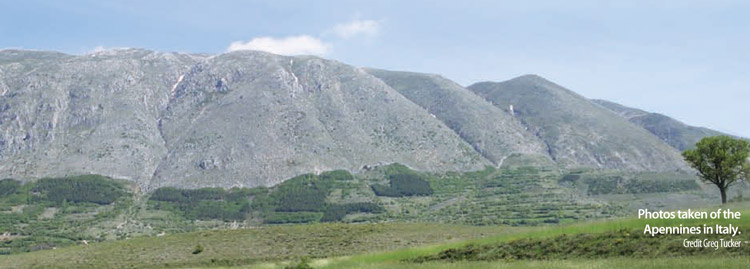
Mountains to Molehills
How different climates sculpt mountain ranges
The Science
The slope of an Apennine mountain is decided by opposing forces: weather erosion and how fast the hillside is emerging from the ground.
more erosion, using this methodology they found that the freezing temperatures in near-glacial climates—periglacial climates—can erode mountain ranges 10 times faster than temperate ones and result in radical shape changes to the mountains.
In the Apennines, for instance, "it really looks like the upper parts of the slopes got almost blasted away," Tucker said.
The explanation for this result lies in the fact that different climates can vary greatly in their power to erode, Tucker said. "At the height of the last ice age, the upper ground level lay in a temperature regime called the 'frost-cracking window'," Tucker said. At temperatures of about –5° degrees Celsius, ice crystals form in the rock; these crystals then grow as thin films of liquid water migrate toward them, he said.
The burgeoning crystals pressurize the rocks from within eventually creating holes and cracks. In the last ice age, this internal freezing effect broke up the rocks and crumbled the hillsides to form gentle mounds of rubble, Tucker said. The current, warmer climate has no such effect, however. "As the rocks slide up from underground, they hardly get touched by erosion at all," he said. "So they are almost a mirror image of the fault plane." The result of the different climatic conditions is broken-up, potholed rocks up high and sheer, intact rock below.
Another unforeseen application for the scientists' novel new model also exists. Using information about the shape of the hill slope and the speed at which the fault is moving, researchers can now determine how fast the current climatic conditions are eroding the rock in certain types of mountain ranges, Tucker said, "which is really cool because until now scientists haven't had many numbers for how fast the rock is weathering."
Once a mountain section or "step" emerges from the ground, winds, rain, sun and snow set to work, wearing down the surface slopes. The higher older slopes, or steps, have seen more of this weathering than the lower slopes, Tucker said. "But unlike steps on an escalator, rocks break down and erode."
If weather erosion is not high in comparison the rate of the mountain uplift the mountain slope remains similar to the angle of the fault plain, Tucker said. But if the erosion is relatively substantial it wears down the slope, he said. "So the slope of a mountain depends on the relative power of tectonics versus erosion," he said.
Tucker and his team hypothesized that the changes in the slope of the mountain front might have a really simple explanation. If the slope has changed in older and younger parts of the slope, it suggests the speed of erosion has changed, Tucker said. So the older, upper parts of the mountain may have seen a different climate than the recent one, he said.
Probing the mountain morphology mystery
To estimate how long-term weather patterns might sculpt mountain ranges, the scientists designed an innovative geometric model using the Apennines as a test case. Although they expected colder, harsher conditions to cause slightly
By Jane Palmer
A harsh climate can wear anyone down, and mountains are no exception. But when it comes to certain mountain ranges, bad weather has done more than erode the surface slopes—it's changed the shape of the mountains altogether, said CIRES Fellow Greg Tucker.
"It is amazing," Tucker, a geologist in CIRES Solid Earth Sciences Division, said. "The power of climate shows up in the shape of a hillslope."
Tucker's fascination with the topic started with his first visit to the Italian Central Apennines ten years ago. There, the gentle, rubble-covered mountaintops perched on incongruously steep, intact bases caught his attention. The change in slope dated from the last ice age, Tucker learned, but why would the change in climate cause such a radical shift in mountain topography?
How did those mountains get there?
This notable change in mountain slope exists in locations where Earth's crust is being stretched, Tucker said. Large blocks slide relative to one another under the crust and mountains form when one block slides up and out of the ground, he said. Mountains are a little like escalators, he said. "Each earthquake is like one step on the escalator because it raises the mountain up and shifts it to one side."



